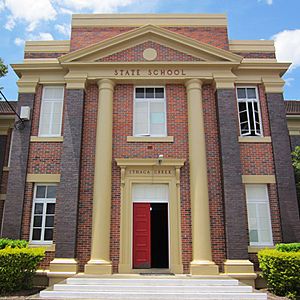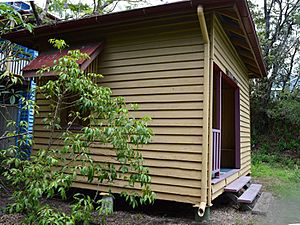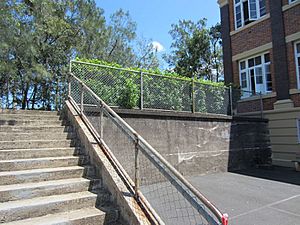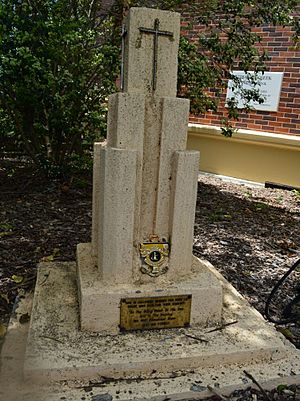Ithaca Creek State School facts for kids
Quick facts for kids Ithaca Creek State School |
|
|---|---|

Front entrance, 2015
|
|
| Location | 49 Lugg Street, Bardon, City of Brisbane, Queensland, Australia |
| Design period | 1919-1930s Interwar period |
| Built | 1930–1939,1932,1934–1936,1934–1936,1939,1946,1946,1947,1954 |
| Architect | Queensland Department of Public Works (Andrew Baxter Leven, Nigel Laman Thomas, and Harold James Parr) |
| Architectural style(s) | Classicism |
| Official name: Ithaca Creek State School | |
| Type | state heritage |
| Designated | 5 February 2016 |
| Reference no. | 650022 |
| Type | Education, research, scientific facility: School-state |
| Theme | Educating Queenslanders: Providing primary schooling |
| Lua error in Module:Location_map at line 420: attempt to index field 'wikibase' (a nil value). | |
Ithaca Creek State School is a historic school and war memorial located at 49 Lugg Street, Bardon, in Brisbane, Queensland, Australia. It was designed by the Queensland Department of Public Works and built between 1930 and 1939. The school was added to the Queensland Heritage Register on 5 February 2016 because of its special history and design.
Contents
A Look Back at Ithaca Creek State School
Ithaca Creek State School first opened its doors in 1885. It's in Bardon, a suburb of Brisbane, about four kilometres from the city centre. The school is important because it shows how state education and school buildings have changed over time.
One of its most important buildings is a large brick school building, built between 1934 and 1936. This building was part of a special project during the Great Depression, a time when many people didn't have jobs. It's a beautiful building that stands out in the area. The school also has well-kept grounds with special walls, a parade ground, a tennis court, and a playing field. There's even a World War II (WWII) memorial dedicated to a group of soldiers called The Rats of Tobruk. The school has always been a big part of its local community.
How Schools Started in Queensland
Providing education was very important to the early governments in Australia. After Queensland became a separate colony in 1859, the number of schools grew quickly. The Education Act of 1860 helped make education more standard. By 1875, the State Education Act made primary education free and compulsory for everyone. This helped most children in Queensland learn to read and write by 1900.
Schools were often the heart of early communities. Local people would often give land or help build the school. Schools became a symbol of progress and a source of pride. Many schools, like Ithaca Creek, also added war memorials or community halls. These places helped bring people together for different events.
To make sure schools were built well and didn't cost too much, the Queensland Government created standard plans for school buildings. For many years, most schools were made of timber because it was affordable. Over time, these designs improved, especially in how they handled the climate, lighting, and fresh air.
Growing with the Community
The land around Ithaca Creek State School was first surveyed in the 1860s. In 1880, a local government area called Ithaca Division was created. By 1884, there was a small post office serving the community.
In the same year, the community asked for land to be set aside for a school. Soon after, a one-hectare (about 2.5 acres) site was reserved. Ithaca Creek State School officially opened on 28 September 1885. It started with a timber building for 60 students, but soon had many more.
The area continued to grow. In 1887, Ithaca Shire was formed, and later, in 1903, it became the Town of Ithaca. This growth was helped by Brisbane's new electric tram network, which made it easier for people to travel. In 1925, the Town of Ithaca became part of Greater Brisbane.
Improving the School Grounds
As the school grew, its grounds needed a lot of work. In 1926, a school committee was formed to make the grounds better for sports and activities. The school grounds were small and rough, so children often played on the road. The committee planned to make the grounds bigger and add things like a swimming pool, gym, and tennis courts.
Over the next six years, the community raised a lot of money, and the government also helped. The school grounds tripled in size, growing to about 7.75 acres. This was a big achievement, especially since it happened during the start of the worldwide economic downturn known as the Great Depression.
Building During the Great Depression
The Great Depression, which began in 1929, caused many people to lose their jobs. To help, the Queensland Government started a big building program. They hired unemployed people to work on projects using local materials. This helped the economy and created useful buildings for the state.
One of these projects was improving school grounds. Workers levelled land for play areas and built retaining walls. This created many large school ovals, which became a common feature of Queensland schools. At Ithaca Creek State School, unemployed workers helped level the newly purchased grounds in 1932. The government spent a lot of money on these improvements, showing their commitment to helping people and building for the future.
In 1932, the Forgan Smith Labor Government came to power. They promised to spend more money on public works to create jobs. This included building new government offices, hospitals, and many schools. Many of these buildings were made of brick and designed in a "classical" style. This style made them look strong and hopeful, which was important during the Depression.
Ithaca Creek State School was one of about 30 schools chosen for a new brick building. These buildings were a clear sign that the government was working to solve unemployment. They were seen as symbols of progress and modern education.
The New Brick School Building
These Depression-era brick school buildings often had similar features. They were usually two storeys tall with an open space underneath (called an undercroft). They were designed to hold many students, sometimes up to 1000. They often had a main entrance in the middle and classrooms along long hallways. The undercroft was used for covered play, storage, and bathrooms.
Even though they had similarities, each brick school building was designed uniquely by an architect from the Department of Public Works. The Chief Architect during this time was Andrew Baxter Leven. Other architects who worked on Ithaca Creek State School included Nigel Laman Thomas and Harold James Parr.
Construction of the brick school building at Ithaca Creek (now called Block A) started in 1934. The first part was the northern wing. The foundation stone was laid by Frank Cooper, the Minister for Public Instruction, on 19 May 1934. The first section was ready in October 1934. The other parts were built in 1934-1935 (the main central part) and 1935-1936 (the southern wing). Concrete retaining walls were also built around the school at this time.
When all three parts were finished, Block A was officially opened on 21 March 1936. The Minister for Public Instruction said the building was part of an effort to provide the best education facilities. The building cost a lot of money and could hold over 1000 children. It had modern features like wide hallways, bright classrooms, and a septic tank system. A bell was added to the roof after June 1936.
Improvements to the school grounds continued. In 1936, the school committee raised money for a sports oval and two tennis courts. A tennis court was opened in 1939. A small tennis shed was also built by 1946. The parade ground was paved in 1969.
Over the years, some parts of Block A were changed. In 1949, parts of the first floor became domestic science classrooms and a teachers' room. A manual training room was built in the undercroft, which later became the tuckshop. In 1979, the verandahs were enclosed with windows.
Community and Memorials
Ithaca Creek State School has a long history of community involvement. People held social dances in the 1930s and raised money for the school pool with events like "lamington drives."
The school also remembers those who served in wars. An Honour Board, listing students who served in WWII, hangs in the foyer of Block A. It was unveiled in 1947.
A WWII Memorial, built after 1954, stands near the front of the school. It honours the "Rats of Tobruk," Australian soldiers who bravely defended Tobruk in North Africa during WWII. The memorial is a smaller copy of a monument built in Libya by the soldiers themselves. It has a stepped design with metal crosses and a plaque that says:
This is hallowed ground for here lie those who died for their country "At the going down of the sun And in the morning We will remember them." Lest We Forget
It's important to remember that this memorial is a replica, and no one is buried at the school.
Ithaca Creek State School has celebrated its anniversaries with special histories and events. In 2015, the school was still operating from its original site. It remains a key part of the community, teaching generations of students and hosting many social events.
School Features
Ithaca Creek State School is on a large, sloping site in Bardon. It faces Lugg Street to the west. The school has many buildings and features. The main building is the Depression-era brick school building (Block A), located in the northwest corner. Other important parts of the school grounds include retaining walls, a parade ground, tennis courts, a tennis shed, a war memorial, a WWII Honour Board, and old trees.
The Main Brick Building (Block A)
Block A is a large, symmetrical brick building with two main floors and an undercroft (a lower, open level). A tall copper spire, called a fleche, sticks up from the tiled roof and holds the school bell. The building is shaped like a "U" around an eastern parade ground. It has a central part and two wings that stick out.
The building looks very elegant with its classical design. It's made of red-brown bricks with decorative parts that look like stone. The main entrance in the middle has a stepped roofline and a large triangular shape (pediment) supported by columns. The words "STATE SCHOOL" are written above the entrance. The front door has "ITHACA CREEK" written on it. A stone near the door shows the building's foundation date, 19 May 1934.
Inside, the building is also symmetrical. The entrance area has a foyer and offices. The central staircase leads to classrooms and storage rooms. The northern and southern wings have large classrooms. Many classrooms still have parts that show where the original dividing walls used to be. Most rooms have plaster walls, carpeted floors, and flat ceilings with timber strips. The stairs are made of painted concrete.
Corridors and enclosed verandahs (porches) provide access to the classrooms. These areas have polished concrete floors. The undercroft level is mostly an open play space. It also has toilets, a tuckshop (which used to be a woodwork classroom), and a storage room.
Many original timber features are still in the building, like tall windows, double-hung windows, and timber doors. Some classrooms even have rare folding timber doors. Most windows and doors still have their original fanlights (small windows above them) and hardware.
Outdoor Areas and Memorials
The school grounds are well-established. There's a large playing field at the southeastern end and two tennis courts south of Block A. One tennis court has been updated for multiple sports. There's also a timber tennis shed (built before 1946) near the western tennis court. It's a low building with a corrugated metal roof and timber walls.
Many old, large trees are in the school grounds, including a big fig tree.
Because the site is on a slope, there are several concrete retaining walls built in the 1930s. These walls create flat areas (terraces) for different parts of the school. There are walls along Lugg Street, between Lugg Street and Block A, and around the playing field. Concrete stairs connect the different levels. From these terraced areas, you can see views of the surrounding neighbourhood.
The parade ground east of Block A offers great views of the building's back.
The Honour Board (1947) in the foyer of Block A lists the names of former students who served in World War II.
The painted concrete WWII memorial (built after 1954) is located northwest of Block A. It honours the Rats of Tobruk. It has a stepped design with metal crosses and the crest of the Rats of Tobruk Association. A plaque on the memorial has a special message, reminding everyone to remember those who died for their country.
Why Ithaca Creek State School is Special
Ithaca Creek State School is listed on the Queensland Heritage Register for several reasons:
- It shows Queensland's history: The school, established in 1885, shows how state education and school architecture have changed. The brick building and landscaped grounds are examples of government projects during the Great Depression that helped the economy and created jobs. The WWII Honour Board and the Rats of Tobruk Memorial show the school community's involvement in the war.
- It's a great example of a Queensland state school: The school has a well-preserved Depression-era brick building, a parade ground, and large landscaped grounds with old trees, retaining walls, and sports facilities. The brick building is a clear example of its type, with its two storeys, undercroft, classical design, and central bell tower.
- It's beautiful and important to look at: The brick school building is large, well-made, and beautifully designed. Its classical style gives it a strong and lasting look, showing the government's hope for the future during the Depression. Its impressive size and design make it stand out in the street.
- It has a strong connection to the community: Schools are always important to their communities. Ithaca Creek State School has a long and strong connection with the people in the area. It was started by local fundraising, and generations of children have learned there. It's a central place for the community, hosting many social and special events.
Notable People from Ithaca Creek State School
- Arch Bevis, who became a Member of the Australian House of Representatives.
- Lloyd Rees, a famous landscape painter.
- William Field Lloyd, who became a Member of the Queensland House of Representatives.





